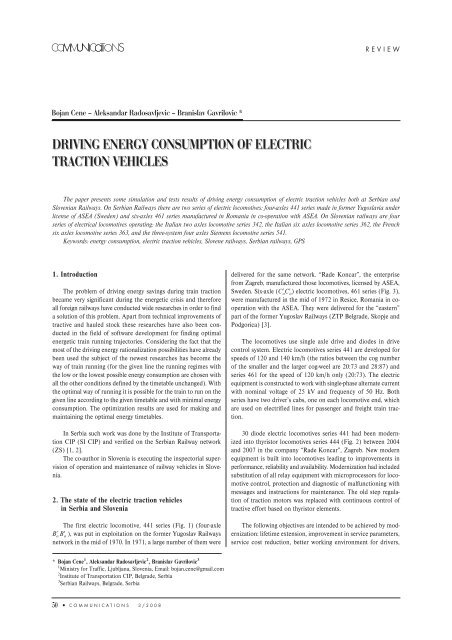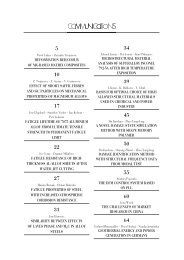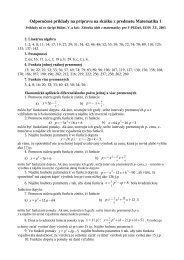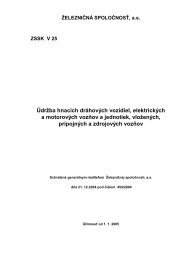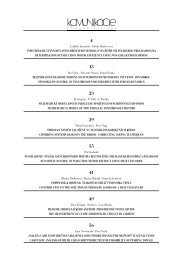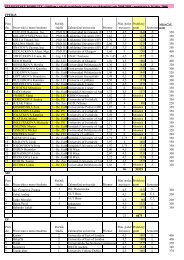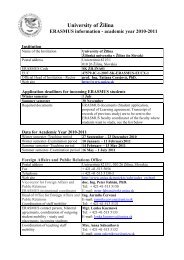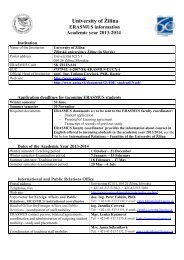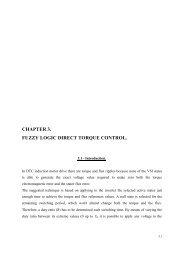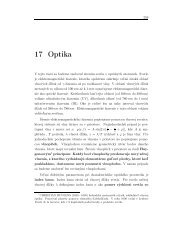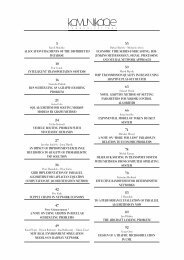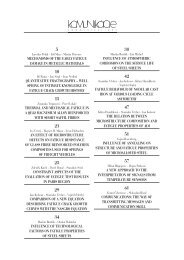simulation of torsion moment at the wheel set of the railway vehicle ...
simulation of torsion moment at the wheel set of the railway vehicle ...
simulation of torsion moment at the wheel set of the railway vehicle ...
You also want an ePaper? Increase the reach of your titles
YUMPU automatically turns print PDFs into web optimized ePapers that Google loves.
REVIEWBojan Cene – Aleksandar Radosavljevic – Branislav Gavrilovic *DRIVING ENERGY CONSUMPTION OF ELECTRICTRACTION VEHICLESThe paper presents some <strong>simul<strong>at</strong>ion</strong> and tests results <strong>of</strong> driving energy consumption <strong>of</strong> electric traction <strong>vehicle</strong>s both <strong>at</strong> Serbian andSlovenian Railways. On Serbian Railways <strong>the</strong>re are two series <strong>of</strong> electric locomotives: four-axles 441 series made in former Yugoslavia underlicense <strong>of</strong> ASEA (Sweden) and six-axles 461 series manufactured in Romania in co-oper<strong>at</strong>ion with ASEA. On Slovenian <strong>railway</strong>s are fourseries <strong>of</strong> electrical locomotives oper<strong>at</strong>ing: <strong>the</strong> Italian two axles locomotive series 342, <strong>the</strong> Italian six axles locomotive series 362, <strong>the</strong> Frenchsix axles locomotive series 363, and <strong>the</strong> three-system four axles Siemens locomotive series 541.Keywords: energy consumption, electric traction <strong>vehicle</strong>s, Slovene <strong>railway</strong>s, Serbian <strong>railway</strong>s, GPS1. IntroductionThe problem <strong>of</strong> driving energy savings during train tractionbecame very significant during <strong>the</strong> energetic crisis and <strong>the</strong>reforeall foreign <strong>railway</strong>s have conducted wide researches in order to finda solution <strong>of</strong> this problem. Apart from technical improvements <strong>of</strong>tractive and hauled stock <strong>the</strong>se researches have also been conductedin <strong>the</strong> field <strong>of</strong> s<strong>of</strong>tware development for finding optimalenergetic train running trajectories. Considering <strong>the</strong> fact th<strong>at</strong> <strong>the</strong>most <strong>of</strong> <strong>the</strong> driving energy r<strong>at</strong>ionaliz<strong>at</strong>ion possibilities have alreadybeen used <strong>the</strong> subject <strong>of</strong> <strong>the</strong> newest researches has become <strong>the</strong>way <strong>of</strong> train running (for <strong>the</strong> given line <strong>the</strong> running regimes with<strong>the</strong> low or <strong>the</strong> lowest possible energy consumption are chosen withall <strong>the</strong> o<strong>the</strong>r conditions defined by <strong>the</strong> timetable unchanged). With<strong>the</strong> optimal way <strong>of</strong> running it is possible for <strong>the</strong> train to run on <strong>the</strong>given line according to <strong>the</strong> given timetable and with minimal energyconsumption. The optimiz<strong>at</strong>ion results are used for making andmaintaining <strong>the</strong> optimal energy timetables.In Serbia such work was done by <strong>the</strong> Institute <strong>of</strong> Transport<strong>at</strong>ionCIP (SI CIP) and verified on <strong>the</strong> Serbian Railway network(ZS) [1, 2].The co-author in Slovenia is executing <strong>the</strong> inspectorial supervision<strong>of</strong> oper<strong>at</strong>ion and maintenance <strong>of</strong> <strong>railway</strong> <strong>vehicle</strong>s in Slovenia.2. The st<strong>at</strong>e <strong>of</strong> <strong>the</strong> electric traction <strong>vehicle</strong>sin Serbia and SloveniaThe first electric locomotive, 441 series (Fig. 1) (four-axleB o B o ), was put in exploit<strong>at</strong>ion on <strong>the</strong> former Yugoslav Railwaysnetwork in <strong>the</strong> mid <strong>of</strong> 1970. In 1971, a large number <strong>of</strong> <strong>the</strong>m weredelivered for <strong>the</strong> same network. “Rade Koncar”, <strong>the</strong> enterprisefrom Zagreb, manufactured those locomotives, licensed by ASEA,Sweden. Six-axle (C o C o ) electric locomotives, 461 series (Fig. 3),were manufactured in <strong>the</strong> mid <strong>of</strong> 1972 in Resice, Romania in cooper<strong>at</strong>ionwith <strong>the</strong> ASEA. They were delivered for <strong>the</strong> “eastern”part <strong>of</strong> <strong>the</strong> former Yugoslav Railways (ZTP Belgrade, Skopje andPodgorica) [3].The locomotives use single axle drive and diodes in drivecontrol system. Electric locomotives series 441 are developed forspeeds <strong>of</strong> 120 and 140 km/h (<strong>the</strong> r<strong>at</strong>ios between <strong>the</strong> cog number<strong>of</strong> <strong>the</strong> smaller and <strong>the</strong> larger cog-weel are 20:73 and 28:87) andseries 461 for <strong>the</strong> speed <strong>of</strong> 120 km/h only (20:73). The electricequipment is constructed to work with single-phase altern<strong>at</strong>e currentwith nominal voltage <strong>of</strong> 25 kV and frequency <strong>of</strong> 50 Hz. Bothseries have two driver’s cabs, one on each locomotive end, whichare used on electrified lines for passenger and freight train traction.30 diode electric locomotives series 441 had been modernizedinto thyristor locomotives series 444 (Fig. 2) between 2004and 2007 in <strong>the</strong> company “Rade Koncar”, Zagreb. New modernequipment is built into locomotives leading to improvements inperformance, reliability and availability. Moderniz<strong>at</strong>ion had includedsubstitution <strong>of</strong> all relay equipment with microprocessors for locomotivecontrol, protection and diagnostic <strong>of</strong> malfunctioning withmessages and instructions for maintenance. The old step regul<strong>at</strong>ion<strong>of</strong> traction motors was replaced with continuous control <strong>of</strong>tractive effort based on thyristor elements.The following objectives are intended to be achieved by moderniz<strong>at</strong>ion:lifetime extension, improvement in service parameters,service cost reduction, better working environment for drivers,* Bojan Cene 1 , Aleksandar Radosavljevic 2 , Branislav Gavrilovic 31 Ministry for Traffic, Ljubljana, Slovenia, Email: bojan.cene@gmail.com2 Institute <strong>of</strong> Transport<strong>at</strong>ion CIP, Belgrade, Serbia3 Serbian Railways, Belgrade, Serbia50 ● COMMUNICATIONS 3/2008


